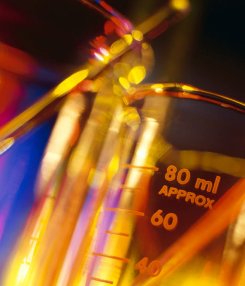22 June 2006
Switchable Stickiness
by Kate Melville
 Researchers from Rensselaer Polytechnic Institute have created an "optically switchable" material that changes from sticky to slippery when exposed to ultraviolet (UV) light. Describing their work in the journal Angewandte Chemie, the chemists involved said that the material could have a wide variety of applications, from a protein filter for biological mixtures, to a tiny valve for "lab-on-a-chip" devices.
Researchers from Rensselaer Polytechnic Institute have created an "optically switchable" material that changes from sticky to slippery when exposed to ultraviolet (UV) light. Describing their work in the journal Angewandte Chemie, the chemists involved said that the material could have a wide variety of applications, from a protein filter for biological mixtures, to a tiny valve for "lab-on-a-chip" devices.
Problems inherent in the lab process of bioseparation drove the researchers to develop the new material. In bioseparation, synthetic polymer membranes are used to filter specific proteins from complex liquid mixtures of biological molecules. But proteins often stick to these membranes, clogging up their pores and severely limiting their performance. "Chemists need an inexpensive way to clean these membranes while they are still in place, rather than periodically removing them from the application environment," researcher Georges Belfort explained. But currently the only cleaning options available involve expensive chemicals or labor-intensive procedures that result in significant down-time.
Switchable stickiness can solve this problem, says Belfort. "We asked ourselves, can one use light to help the proteins hop-on and hop-off? We have shown that when one changes light, the proteins don't stick as well," Belfort explained.
To create the new material, Belfort attached spiropyran molecules to a widely used industrial polymer, polyether sulfone. Spiropyrans are a group of light-switchable organic molecules that exist in a colorless, "closed" form under visible light, but switch to a reddish-purple, "open" form when exposed to UV light. This change leads to an alteration of the new material's polarity, or the chemical structure of its atoms. In switching from non-polar to polar, the material becomes less attractive to proteins that might stick to its surface. Exposing the material to UV light is like flipping a molecular switch, causing sticky proteins to detach from the surface and wash away in the liquid.
Not only is the switching mechanism uncomplicated, but so is the patented procedure required to graft spiropyran molecules to polyether sulfone. "We used a relatively simple two-step process that could be easily incorporated into a commercial manufacturing process," Belfort said. And it's not just bioseparation applications that will benefit. Belfort envisions a number of potential applications for the materials, ranging from new membranes for treating polluted water to the targeted release of drugs in the body. "The relative ease of this grafting and switching process suggests many industrial opportunities," Belfort said in conclusion.
Source: Rensselaer Polytechnic Institute
